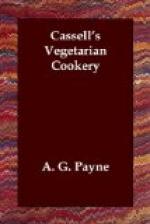to ordinary stomachs. We may mention saw-dust
as one of the ingredients used for the purpose.
Again, if you attempt to make whole-meal bread into
loaves, you will find great difficulty in baking the
loaves. This whole-meal is a very slow conductor
of heat, and the result will probably be that the outside
of the loaf will be very hard while the inside will
be too underdone to be eaten. Consequently, should
you wish to have home-made whole-meal bread, it is
far best to bake it in the form of a tea-cake or flat-cake.
We cannot do better, in conclusion, than quote what
Sir Henry Thompson says on this subject:—“The
following recipe,” he says, “will be found
successful, probably, after a trial or two, in producing
excellent, light, friable, and most palatable bread:
To two pounds of coarsely ground or crushed whole-meal,
add half a pound of fine flour and a sufficient quantity
of baking powder and salt; when these are well mixed,
rub in two ounces of butter, and make into dough with
half milk and water, or with all milk if preferred.
Make rapidly into flat cakes like ‘tea-cakes,’
and bake without delay in a quick oven, leaving them
afterwards to finish thoroughly at a lower temperature.
The butter and milk supply fatty matters, in which
the wheat is somewhat deficient; all the saline and
mineral matters of the husk are retained; and thus
a more nutritive form of bread cannot be made.
Moreover, it retains the natural flavour of the wheat,
in place of the insipidity which is characteristic
of fine flour, although it is indisputable that bread
produced from the latter, especially in Paris and
Vienna, is unrivalled for delicacy, texture, and colour.
Whole meal may be bought; but mills are now cheaply
made for home use, and wheat may be ground to any
degree of coarseness desired.”
CHAPTER XIV.
PIES AND PUDDINGS.
In vegetarian cookery, as a rule, pies and puddings
are made in the same way as in ordinary cookery, with
the exception that we cannot use lard or dripping
in making our pastry. Nor are we allowed to use
suet in making crust for puddings. It would have
been quite impossible to have given even one quarter
of the recipes for the pies and puddings known, and
we must refer those who wish for information on this
subject to “Cassell’s Shilling Cookery,”
where will be found a very complete list, but which
would have occupied the whole of the space which we
have devoted to recipes where vegetarian cookery,
as a rule, differs from the ordinary.
We will, on the present occasion, confine our attention
to the two points we have mentioned, viz., how
to make pastry without lard or dripping, and pudding
crust without suet. The first of these two points
causes no difficulty whatever, as the best pastry,
especially that known as puff paste, is invariably
made with butter only as the fatty element; but there
is one point we must not overlook.




